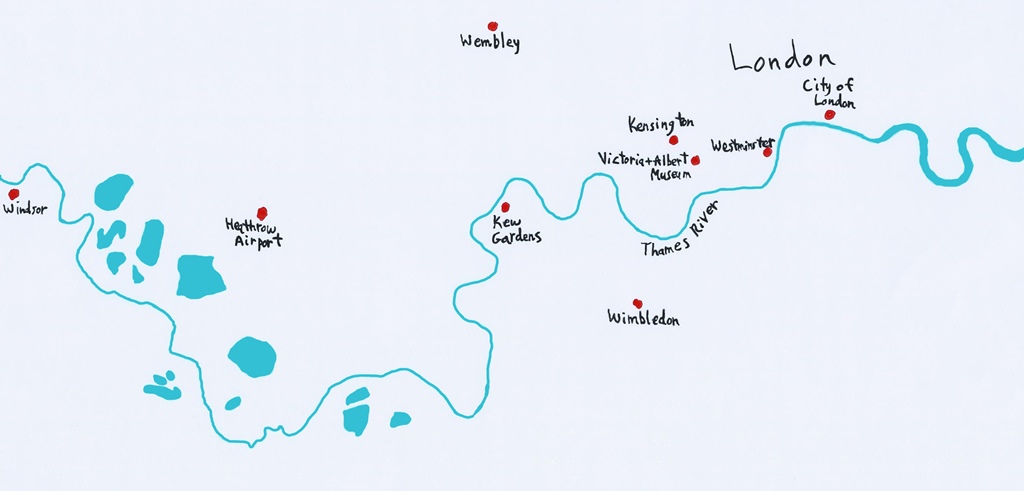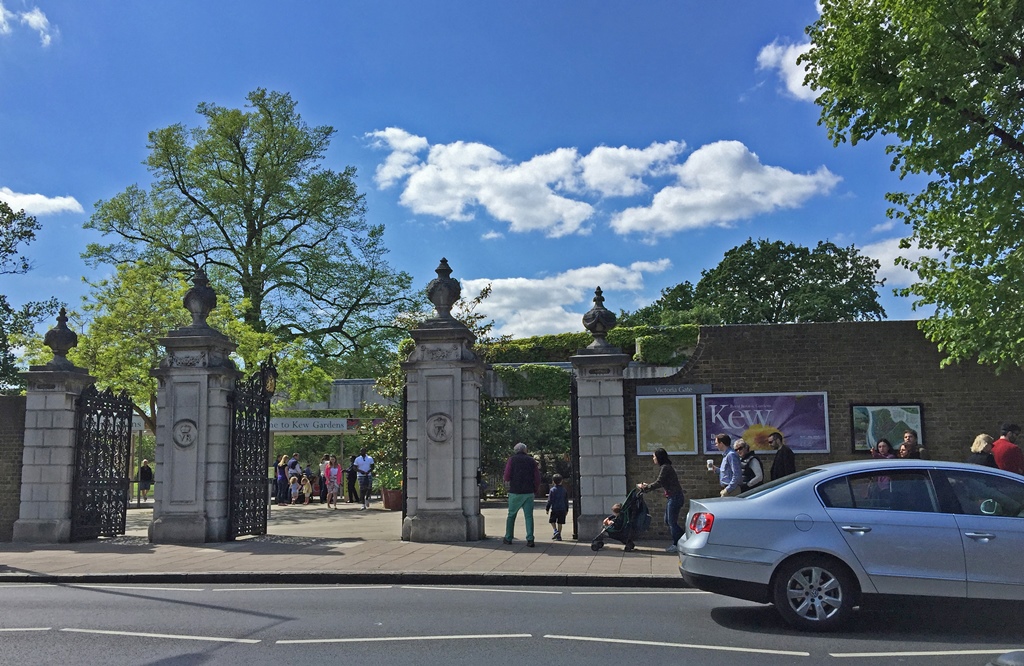London Area
Our next destination was Kew Gardens, which has been described as having "the largest
and most diverse botanical and mycological collections in the world". If you're ever
in London and you're into gardening, or have ever seen a garden that looked kind of
nice to you, you should probably go to Kew Gardens too. It's in the London Borough of
Richmond upon Thames, along the river (as you've no doubt deduced from the name), well
to the west of the center of town. You can get there on the Underground, which will
drop you off a short walk from a Garden entrance called the Victoria Gate.
Victoria Gate Entrance
Kew Gardens covers 330 acres, much of it wooded and much of it on the parklike side. Many
of the thousands of plants living at the gardens come from different climates and would
not survive a London winter, and for them there are several structures, scattered around
the grounds, in which the climate can be controlled. And there are additional structures
which exist for decorative or historical reasons. We could easily have spent the entire
day exploring all of this, but our time in London was growing short, and we had another
destination we wanted to visit for part of the day. So unfortunately we weren't able to
explore the entire garden, and only ended up seeing about half of it, roughly the right
half of the map below. But I'm sure you'll agree we had plenty to look at in our half-day
visit. And, of course, we'll have to return someday.
Kew Gardens
Kew Gardens started to acquire something like its present form under George III, who
undertook the enrichment of the gardens beginning in 1772, with the advice of some of
the prominent botanists of the time. One of the botanists, Joseph Banks, had made a
name for himself by travelling to distant points of the globe and bringing back
samples of plants utterly foreign to England or to any other place in Europe. In
1766, he'd crossed the North Atlantic to Labrador and Newfoundland, and in 1772 he'd
visited some of the British Isles and ventured as far as Iceland. But most famously,
in 1768-71 he'd accompanied Captain James Cook on a trip around the world aboard the
HMS Endeavour, during which time he'd studied the flora and fauna of places like
South Africa, Brazil, Tahiti, New Zealand and Australia. He brought back samples and
seeds, some of which found their way into the Royal garden.
Sir Joseph Banks
Banks soon became the unofficial director of the garden. In addition, in 1778 he was
elected President of the Royal Society, a position he would hold for 41 years. With
these dual roles, Banks was able to send out explorers to find more exotic plants and
to encourage general shipping to the many far-flung British colonies to bring back
samples from foreign ports. By the time Banks died in 1820, the collection at Kew
was formidable to say the least. In 1840 Kew was opened as a national botanical
garden, and the rest is history.
In addition to the structures and the plants, we noticed on our map that Kew Gardens
was also home to two bodies of water. We turned right toward the closest one, called
the Palm House Pond. On the far side of the pond, there was a picturesque
three-story building, dating from 1857, which is apparently just called "Museum No.
1". At present, Museum No. 1 holds an education center and a restaurant.

Palm House Pond and Museum No. 1

Waterfowl
You're probably thinking that if there's a Palm House Pond, there must be a Palm House
somewhere. You would be correct, and from our vantage point at the pond, it's
impossible to miss, if you turn around. The Palm House is an immense wrought-iron-and-glass
structure that was built between 1844 and 1848 by architect Decimus Burton and iron founder
Richard Turner. If the idea of a Palm House and the name Turner seem familiar, you have a
really good memory. You have only to look at the page for the
Belfast Botanic Garden
to see a similar (but considerably smaller) structure that was built in 1840, with the
participation of the same Richard Turner.

Palm House Pond and Palm House

Nella and Palm House

Flowers in Front of Palm House

Belfast Palm House
The Palm House is one of those climate controlled buildings I mentioned earlier. Inside,
no surprise, you can find palms of various types. But we went into the house and found
that there are a whole lot of other plants that apparently share the same climate
preference.
Palm House Canopy from Upstairs Walkway

Among the Plants

A Palm

Beehive Ginger (Malaysia)

Taro Plant

Quesnelia Liboniana (a Bromeliad)

A Bromeliad

Zebra Plant

Pandanus Vandermeeschii

Encephalartos Horridus

Eastern Cape Giant Cycad from 1775

Curly Spiky Leaves

Red-leaved Plant
Also in the Palm House, there were some small ponds and aquariums. With pond and
aquarium plants and creatures.

Underwater Plants, Garden Eel

More Underwater Plants
Fish, Palm House Aquarium
After having our fill of the Palm House, we went out the back way, to see if the scenery
was any different. It was, somewhat, but the first thing that caught our attention was
a statue of a dangerous-looking creature. This was one of the "Queen's Beasts" - a
series of statues of creatures that appear in the coats of arms of the Queen's royal
predecessors. This one is the Griffin of Edward III (1312-77):
Palm House and Griffin of Edward III
Next to the Palm House, but much smaller, is the Waterlily House, built in 1852 (ironwork
by the aforementioned Richard Turner). Like the Palm House, this structure is aptly named,
as it has a large pond in the middle, with waterlilies floating all over it. But not just
any waterlilies - some have the biggest lilypads you will have ever seen. But there are
normal-sized waterlilies too, plus other plants that enjoy the same heat and humidity.

Bob and Waterlily House

Giant Waterlilies

Inside the Waterlily House

Lilypads and Waterlilies

Inside the Waterlily House

Waterlilies, Papyrus and Chenille Plant
Not far from the Waterlily House is the much newer and more wordily-named Princess of
Wales Conservatory. The Conservatory was opened in 1987 by Diana, Princess of Wales, but
the Conservatory was not named for her. It was named for Princess Augusta of Saxe-Gotha,
who had the Gardens greatly enlarged before her son succeeded to the throne as George III
in 1760.

Nella and Princess of Wales Conservatory

Flowers, Princess of Wales Conservatory
In the Conservatory there are ten micro-climatic zones, with their climates controlled by
computer. One of the largest zones has a desert climate, and many spiky plants can be
found here:

Cactus, Princess of Wales Conservatory

Cactus Garden

Cactus Garden

Cleistocactus Winteri and Euphorbia Milii

Mammillaria Spinosissima or "Spiny Pincushion Cactus"

Echinocactus Grusonii or "Golden Barrel Cactus"

Echinopsis Strigosa

Cactus
The other zones in the Conservatory are more humid, and there are more flowers. I'm not
sure what they all are, but they smell pretty good. Except for the corpse flower, of
course, which fortunately wasn't blooming. One of these other zones was also guarded by
a dinosaur.

Yellow Flowers

Pink Flowers

Orchids

Amorphophallus Titanum, or "Corpse Flower"

Caladium Bicolor

Inside the Tropical Garden

Orchids

Orchids

Pink Flower

Chinese Water Dragon
From the Conservatory, we walked over to Kew Palace, which seemed to consist of a single
unpalace-like manor house.
Kew Palace
Kew Palace is all that's left of a larger palace complex, that's most well-known for its
use by George III and his wife, Queen Charlotte.

George III, Sir Joshua Reynolds (ca. 1759)

Queen Charlotte, Johann Georg Ziesenis (ca. 1761)
A lot happened during the 60-year reign of George III, but it's impossible to discuss his
reign in much detail without recognizing his bouts with mental illness. It's not clear
exactly what kind of mental illness this was, but it seemed to match up with the mania
phase of being bipolar. In any case, there were periods during which the King could not
function, and he needed to be removed from the public eye while undergoing treatment.
Sometimes he would go to Kew Palace, where he would stay with his handlers in a more
palatial building (since demolished) known as the White House, while his family would
stay in the surviving structure, known as the Dutch House (as it was built, around 1631,
by a Dutch merchant). During his final illness, the King instead stayed at Windsor,
while his son (the eventual George IV) ruled as regent. The Dutch House has been
furnished and decorated to give some idea of what life was like for the Royal family
while they were staying there.

Dinner Table with Fake Food

Key to Fake Food

Queen's Boudoir

Queen's Drawing Room

Princess Elizabeth's Bedchamber

Princess Elizabeth's Bedchamber

Queen's Bedroom

Servants' Room
Behind the Dutch House, there are a couple of smallish gardens (by Royal standards, anyway).
One was used for the growing of household plants (herbs, medicinal plants, some vegetables).
This garden has been restored to reflect approximately what it looked like when in use.

Medicinal Garden

Central Art Object, Medicinal Garden

Covered Walkway

Covered Walkway
Big White Flowers
The other garden is more ornamental, and has a well and a fountain.

Palace Garden

Cupid Fountain, Palace Garden
Kew Palace from Garden
Running short on time, we walked back toward the Victoria Gate by a non-direct path,
in order to see a little more of the Gardens.

Garden Grounds

Flowering Bushes
On the way we found some lunch (there are a few places to eat in Kew Gardens), and then
headed out the gate and back to the Underground station. We caught a train and headed back
toward town. But not too far back toward town, as our second destination for the day was
on the way. This destination was the Victoria and Albert Museum.










































































